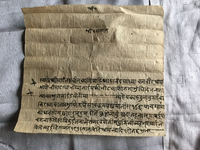A receipt from the Patan Tahabila acknowledging payment of a fine by five headmen of Pācapārvā (VS 1913)
ID: Tsum_0001_0032
Edited and
translated by Nadine Plachta and Rajendra Shakya
Created: 2017-05-19;
Last modified: 2021-12-15
For the metadata of the document, click here
The accompanying edition, translation/synopsis and/or commentary are available under the terms of the Creative Commons Attribution-ShareAlike 4.0 International License
Abstract
This receipt was issued by Māhānaṃda Pādhyā and Balabīra Thāpā, two office attendant of the Patan account office (tahabila), to five headmen of Pācapārvā. It records the payment of an outstanding fine for not turning a deserter from the Tibetan army back over to it. The officials state that they received a sum of 146 rupees, which had remained after the headmen had deposited only part of the fine stipulated in an earlier order.Diplomatic edition
[1r]
1श्री१1श्री५जनरल1X1X1स्वस्तिश्रीपाटंतहवील्कासिपाहिमाहानंदपाध्या∙वलवीरथापा2आगे∙नीमाटस्यांभोट्यालाईपक्रीभोटकाफौजमाशुंपिदिननजां
3न्याकाकुरामाडंडकेरौमा¯ ¯ ¯ ¯ ¯साहेवकाहजुमावुझाईवां
4किरह्याकातमशुकिरुपैय़ाय़कसय़छयालीस्१४६पांचपार्वा
5कोघनसोम्छाङडुन्डुपदोर्जे∙फुन्जोनोर्वु∙व़ाङज्यूनाम्गाम्ईपा
6चजनाहस्तेहामिदुईजनालेसनद्वमोजिमवुझिलिञ्यूभरपाईले
7षिदिञ्यूइतिसम्वत्१९१३सालमितिश्राव़नवदि१रोज६शुभ्म्¯¯¯¯
Translation
[1r]
Śrī 1
Śrī 5 General
Hail! Attendants (sipāhī) of Śrī Patan accounting office (tahabila) Māhānaṃda Pādhyā [and] Balabīra Thāpā.
Āge: After they paid to [Śrī 5 General] 1 sāheba in Kerung the fine [that was imposed on the five headmen of Pāṃcapārvā2 ] for not apprehending Nīmāṭasyaṃ Bhoṭyā 3 and handing him over to the Bhoṭa army, we (i.e. Māhānaṃda Pādhyā and Balavīra Thāpā) received thė remaining amount of one hundred and forty-six rupees, Rs 146, [mentioned in the] tamasuka, [and] in accordance with the sanada, from the following five ghanasoms4 : Chāṅa Ḍunḍupa, Dorje Phunjo, Norbu, Vāṅjyū and Nāmgām from Pāṃcapārvā. [We] have issued a receipt [for the same].
Friday, the 1st of the dark fortnight of Śrāvaṇa in the [Vikrama] era year 1913 (1856 CE). Auspiciousness.
Commentary
There is reason to assume that this document, written during the early reign of Jaṅga Bahādura Rāṇā (1846–1877), is a copy, as it does not bear any seal. It does contain, however, several interesting features.
Below the invocatio, it bears the inscription 'Śrī 5 Janarala'. This is confusing, because Śrī 5 usually is a title reserved for members of the Śāha family. Further on in the text this expression is followed by janarala sāheba. Sāheba is commonly used for the crown prince. But in this context cīpha sāheba refers to the commander-in-chief general (kamyāṇḍara ina cipha janarala) who, according to the Rāṇā Roll of Succession, was the next younger brother in line to serve as prime minister.
It was Jaṅga Bahādura who first held the title Śrī 3 Mahārājā. It was bestowed on him through a lālamohara by King Surendra in 1856, who subsequently made him Mahārāja of Kaski and Lamjung. Jaṅga Bahādura proceeded to gain absolute power over the kingdom, reducing the Śāha monarch to a figurehead and making the prime minister and other government positions hereditary (Agrawal 1976: 10).
Later on the title mukhtiyāra, which was used to refer to the prime minister during the Śāha dynasty, was bestowed upon the cīpha sāheba, the commander-in-chief, who headed the executive government and the military (Agrawal 1976: 32).
The commander-in-chief general was the second position within the governing hierarchy of the state, just below Śrī 3 Mahārājā. Male members of the Rāṇā family were in queue, well defined on the basis of agnatic seniority, to occupy the top positions. Most of them were brothers of Jaṅga Bahādura, followed by his sons.
The present document was written almost at the same time as Jaṅga Bahādura had the title Śrī 3 Mahārājā of Lamjung and Kaski conferred upon him.

